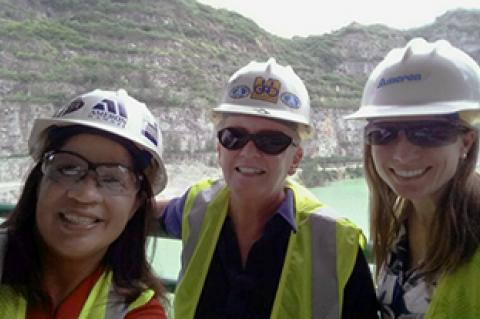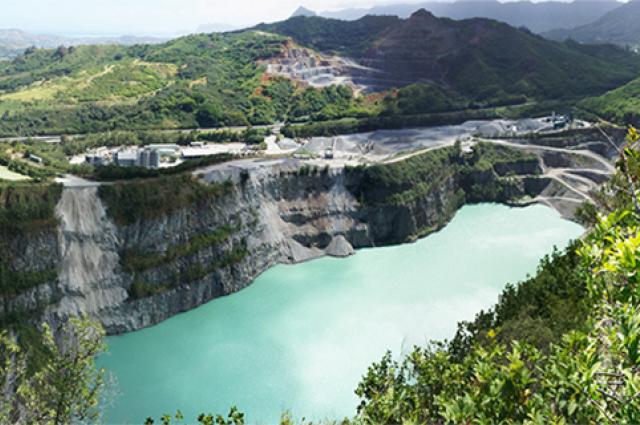Industrious Senior Builds a Mining Life in Hawaii
|
Editor’s note: Part of The New Face of Mining celebration -- in which the University of Arizona is commemorating the 125th anniversary of the founding of the Arizona School of Mines -- this is one in a series of articles profiling mining and geological engineering interns.  On the job at Kapaa Quarry: Jamie Mills, environmental and mining engineer (right), TrudyLynn Pedro, safety officer (left), and Linda Goldstein, manager of environmental affairs. See All the UA Mining Engineering Intern Stories: Jamie Mills Builds Mining Life in Oahu Brothers Peter and Paul Mather Carving Niches |
As far as mining internships go, Jamie Mills’ experiences have been anything but ordinary. She spent summer 2013 working as an environmental/mining engineer at the 50-year-old Kapaa Quarry on the island of Oahu, helping Ameron Hawaii more efficiently pull basalt for concrete and asphalt out of one of the calderas that formed the island.
Mills set her compass for Hawaii, Googled the company, sent her resume and packed her bags. The rest is history, or the start of a new beginning.
“I just didn’t sit around and wait for the phone to ring,” she said.
The company didn’t have an internship program, per se, at least not until Mills’ arrival.
“Jamie is an exceptional young professional, and future interns will have to work hard to meet the standards she set for interning,” said Linda Goldstein, Ameron Hawaii manager of environmental affairs. “We are so pleased with the experience that we plan to hire more interns in the future.”
On the Management Fast Track
The aggregate mining company -- which operates in Oahu and Maui and is a subsidiary of Ameron International Corp. -- provided more opportunities for management experience and training than a company mining metals would offer, Mills said.
“Aggregates move faster than metal. There are a lot more opportunities to move up into management.”
There were civil engineers and mechanical engineers among the workforce of about 70 at the quarry, but no mining engineers -- probably because aggregate mining traditionally has been focused on the end product, the processing of a construction material. The majority of the people with whom Mills worked were in their 50s and 60s and will be retiring in the next 10 to 15 years. In fact, much of the work Mills was hired to do had been done previously by retiring civil engineers, quarry superintendents, and environmental engineers, not mining engineers.
“There is value in having a person with a strong mining engineering background, and fresh ideas, helping with the workload,” Goldstein said, “especially for a mine in a remote location like Hawaii.”
Last summer Mills assessed the cost-effectiveness of replacing diesel fuel with cleaner burning biodiesel and propane, and evaluated solar and wind power to supplement electricity. She redesigned haul roads and proposed to the president of the company new technology and methods to locate ore, model mining operations, and improve safety. Though aggregate mining was new for Mills, the engineering skills she has learned at the University of Arizona were readily adaptable.
“Our school focuses on copper and metal, but what you learn through metal mining and how to do an open pit design with the latest technology, that same concept applies to an aggregate mine,” she said.
The senior is headed back this summer to finish what she started -- integrate the new technology to help optimize mine operations, and lay a solid foundation for a job in mine management. Mine managers there are already looking at the possibility of making her employment permanent.
“Jamie brought some new ideas and methods that we will be implementing starting this year,” Goldstein said. “I’m sure that she will help us move successfully into the next 40 years of the quarry’s life.”
Making the Shift to Mining
Though this is Mills first engineering internship experience, it is not her first summer job in the mining industry. While attending core engineering classes at Pima Community College in Tucson, Arizona, she spent a summer working as a water truck driver at the Freeport-McMoRan Sierrita mine near Tucson.
Mills had no idea early in her career that she would end up in mining. She was working as a certified nursing assistant and taking nursing classes at Pima when she made the switch to engineering, but even then mining wasn’t yet on her radar.
“I had looked over the engineering options at the UA a hundred times, and I don’t even remember seeing mining. My eyes just skipped it every time.”
A mining presentation in one of her Pima classes the summer of 2011 got her thinking.
When the instructor first announced the UA mining and geological engineering speaker, Mills thought, “How lame.”
“I’m like, seriously, who mines? Are you kidding me right now?”
After the presentation, she went home and did some research. She ran across the familiar saying, “If it can’t be grown, it has to be mined.”
Mills sat back and looked around her house and out the window. And then it happened, the shift.
“I realized everything in our lives was mined or was touched by a mine,” she said.
After meeting people in the department and touring the UA student-run San Xavier Underground Mine, Mills was hooked.
“I fell in love with everybody and all of it,” she said. “I think it’s because I know it is important.”
Mills transferred to in the UA mining and geological engineering department in fall 2012 and has never looked back. It was already in her blood, anyhow.
“My dad was an accountant. My aunts were engineers. Another aunt was an accountant. Grandpa was an engineer,” she said.
Adapting to Life in Hawaii
The 28-year-old, who left the Detroit area five years ago to escape the relentless cold and soaring rates of unemployment, has already formed an attachment to what she described as a relaxed, friendly, family oriented atmosphere unlike any she has ever experienced.
“There was a woman ahead of me in line at the grocery store, and she got milk and something else. Her bill was $5-something. And she was talking about how much it was,” Mills said. “Then this Hawaiian woman turns around and looks at everybody in line, and says ‘Yeah, but we’re in Hawaii!’ And she grabbed her bags and left.” Aloha!
In Kailua, a town where pigs and chickens roam free, Mills lives a few miles from the seashore near the quarry, at which incidentally, the tropical scenes from Godzilla 2014 were filmed last summer. She spends her spare time surfing and hiking.
Another summer interning in Hawaii, one more bittersweet semester, then hopefully Mills’ next big decision will be where to drop anchor -- whether to live in a yacht, also known as a houseboat, on Kane’ohe Bay or in a home under the palm trees.
“If I land that job there and everything works out, I will park it,” she said.


